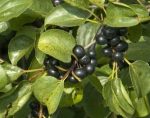 Common buckthorn is a suckering deciduous shrub or small tree growing up to 25’ tall and a member of the buckthorn family Rhamnaceae that also includes wild lilacs (Ceanothus) It is native to Europe, northwest African and western Asia but was introduced into North America as an ornamental in the early 19th century and has become invasive from New Brunswick and Alberta, south to Virginia and Wyoming where it grows in a is disturbed sites such as fence rows and roadsides, ravines, riverbanks, and deciduous woods. The plant has gray-brown bark and twigs tipped with a sharp spine. The dark green leaves are oval and up to three inches long with three curved veins. The male and female flowers are produced on different plants in clusters of two to six in spring. They are fragrant, yellow-green and female flowers give way in the fall to small purple to black fruit that have 3-4 seeds and are attractive to birds. Although common buckthorn has been used in the past for hedges, screens, and windbreaks, their invasive nature should preclude their use in the future. The generic name, Rhamnus, comes from the Greek name for spiny shrubs. The specific epithet, cathartica, comes from the Greek word kathartikos meaning cleansing in reference to purgative effects of bark, leaf, and fruit preparations.
Common buckthorn is a suckering deciduous shrub or small tree growing up to 25’ tall and a member of the buckthorn family Rhamnaceae that also includes wild lilacs (Ceanothus) It is native to Europe, northwest African and western Asia but was introduced into North America as an ornamental in the early 19th century and has become invasive from New Brunswick and Alberta, south to Virginia and Wyoming where it grows in a is disturbed sites such as fence rows and roadsides, ravines, riverbanks, and deciduous woods. The plant has gray-brown bark and twigs tipped with a sharp spine. The dark green leaves are oval and up to three inches long with three curved veins. The male and female flowers are produced on different plants in clusters of two to six in spring. They are fragrant, yellow-green and female flowers give way in the fall to small purple to black fruit that have 3-4 seeds and are attractive to birds. Although common buckthorn has been used in the past for hedges, screens, and windbreaks, their invasive nature should preclude their use in the future. The generic name, Rhamnus, comes from the Greek name for spiny shrubs. The specific epithet, cathartica, comes from the Greek word kathartikos meaning cleansing in reference to purgative effects of bark, leaf, and fruit preparations.
Type: Deciduous shrub or small tree
Outstanding Feature: Fruit for wildlife
Form: Rounded crown
Growth Rate: Rapid
Bloom: Clusters of two to six fragrant, yellow-green male and female flowers on different plants in clusters of two to six in spring
Size: 16-25’ H x 10-15’ W
Light: Full sun to part shade
Soil: Average, medium moist, well-drained
Hardiness: Zones 3-8
Care: Low maintenance
Pests and Diseases: Leaf spot, powdery mildew, aphids, scales, and rusts
Propagation: Seed